 home
about
artists
exhibitions press
contact
purchase
home
about
artists
exhibitions press
contact
purchase |
|||||
|
Press about M.F.Husain
"... I am no longer a young man who has a physical need to be in India to be Indian. Whether I paint in New York or Paris, I am an Indian painter. A few people don't understand modern art, that's all." (M.F.Husain, Painter)
New Delhi Maqbool Fida Husain (better known as M.F. Husain among art aficionados) never asked for Qatari nationality but feels honoured that the emirate's rulers are ready to count him as one of their own citizens. Speaking to Gulf News from Dubai, his son Mustafa said his father has responded positively to Qatar's gesture. Many from the art fraternity, however, still do not believe that the self-exiled artist, who turns 95 this year, will take up Qatar nationality. Their indignation inevitably boils down to the argument — how is it that Husain feels safe in Qatar and not in India? All these years, Husains's art captured India's ethos. His work has taken him all over the world. Born in Pandharpur in Maharashtra state, the acclaimed painter has travelled to New York, China, Russia, Paris and London for a good 60 years now. However, in 2006, right wing activists took umbrage at some of his paintings and galleries showcasing his work were vandalised. The rumblings had begun in the 1990s, with some of Husain's works stirring controversy because of their allegedly inappropriate portrayal of Hindu deities. The paintings, some going back all the way to 1970, did not become an issue until 1996, when a Hindi monthly magazine published them to beef up an article. Criminal cases were filed against the painter. The controversy escalated in 2006, when Husain was charged with hurting sentiments of people with his nude portraits of Hindu deities. Then began the game of competitive intolerance, with cases filed under section 295 of the Indian Penal Code, which outlaws insulting religions and section 153 A, which deals with promoting enmity between groups. Husain's friends quoted the liberal tradition of Indian culture through the ancient times where depiction of nudity had found place as decorative sculptures on the walls of the temples in Khajuraho and Konark. Diverse views
There were diverse views. The liberals said that an artist had the freedom to paint what he liked and that if some Hindus were offended by his works, they could simply ignore them. Such critics had no right to restrict creativity, they argued. They sought to question why people who liked his paintings were to be denied the opportunity to see his work. His ardent fans and supporters claimed that Hindu fundamentalists deliberately portrayed him as a Muslim who delighted in offending Hindus. They pointed out that Husain's paintings were a tribute to an ancient tradition but the word ‘vulgar' had been deliberately attributed to his artistic interpretations to give matters a vicious twist. Husain's case is now being seen as a test of two issues — how much liberty can one take in the name of ‘freedom of expression'? And whether it is legitimate to incite violence if someone were to feel offended, as has been happening ever so often now across the country. Husain has always maintained that the cases lodged against him infringed upon his basic right to express himself and said that he didn't want to hurt anyone's sentiments through art. He has apologised, explained and clarified, on various occasions. But this did not satisfy his detractors who hounded him and kept up vehement protests. Cases piled up against Husain in courts all over India. The final straw was the vandalisation of his galleries and attacks on his home in Mumbai. Such was the intensity of the hate campaign that monetary rewards were promised if anyone were to inflict personal injury on him. The artist left the country in February 2007 and ever since, has flitted between London, Dubai and Qatar. After he left India to escape harassment, the courts quashed the cases and came in defence of art. The judges not only labelled the charges as baseless but ticked off the complainants. Some cases were transferred to Delhi. No criminal proceedings In fact, a bench headed by the Supreme Court chief justice K.G. Balakrishnan, had, in September 2008, refused to initiate criminal proceedings against Husain for allegedly hurting public sentiments through some of his paintings. Last year, it clubbed some of his cases in a bid to clear the mess. But no hearing has been held and no clear order absolving him has come. The Qatar government's citizenship offer has now queered the debate. Since Indian laws do not allow dual citizenship, accepting Qatar's citizenship offer automatically means giving up Indian nationality. Husain's fans are hopeful and look forward to having him back. Home minister Palaniappan Chidambaram too has stated: "There is no threat to Husain's security. He will be given adequate security if he returns to India." Chidambaram emphasised: "Cases in the lower courts should not deter him from returning to the country of his birth. We would be happy to receive him in India." Husain says, "India is my motherland. I can't hate my motherland. But when I was targeted, people kept silent. I know the entire India is now with me, except 1 per cent people. "I am no longer a young man who has a physical need to be in India to be Indian. Whether I paint in New York or Paris, I am an Indian painter. A few people don't understand modern art, that's all." The fundamentalists are unapologetic. "The painter would have to apologise and destroy his controversial paintings if he wants to return," they say. Speaking from Mumbai, Husain's daughter Raeesa questioned the fuss in the media over her father. "Why does the Press pick up things when the subject is hot and later forgets all about it," she asked. "Wouldn't it do well if it pursued the case and brought home some positive results?" Coming from friends and fans it would mean another thing, but hopes of a daughter to stay close to her father in his twilight years is not asking for much. Court Cases: Extradition ruled out Gulf NEWS: Since there are court cases against M.F. Husain, can he be extradited to India? PALANIAPPAN CHIDAMBARAM: The court cases against Husain are in India. No one has sought his extradition to India. There is no Extradition Treaty or Mutual Legal Assistance Treaty with Qatar. With cases against him, if he were to visit India, could he be arrested? I don't think that there is any danger [of] Husain being arrested if he returns to India. While the possibility cannot be ruled out, I think it is extremely unlikely that anyone would seek his arrest or any police authority would actually arrest him. You have stated that Husain will be provided adequate security if he returns. Did the home ministry officials contact him or his family directly on the security issue? What was their reaction? Yes, security would be provided to Husain if he returns. The Union home secretary had directly talked to Husain and offered security to him on his return, which he accepted. Before leaving for Dubai in 2006, did Husain or anyone on his behalf approach the home ministry seeking security? No. But without waiting for a request from him, the then home minister had already written to the Maharashtra government to provide him adequate security. Does the home ministry see Husain accepting Qatari citizenship as a serious embarrassment? No. Husain did
not inform the home ministry that he was inclined to accept Qatar
citizenship. G. Gurucharan, Joint Secretary, Ministry of Overseas Indian Affairs Dual Citizenship/Overseas Citizenship of India "The Constitution of India does not allow dual citizenship, which means holding Indian citizenship and citizenship of any country simultaneously. The government grants Overseas Citizenship of India (OCI), which people mistakenly refer to as dual citizenship. "In response to a long and persistent demand for ‘dual citizenship', particularly from the Diaspora in North America and countries in West Europe, Australia and New Zealand, the OCI Scheme was launched in August 2005. This was done by amending the Citizenship Act, 1955, during the Pravasi Bharatiya Divas, 2006. "The government offers a modified form of dual nationality. It gives Persons of Indian Origin (PIO) the right to live, work and buy property in India, other than agricultural land and plantation property. Different from a PIO card, it gives more economic rights and greater symbolic value; since a registration document is provided. "PIO of certain category who migrated from India and acquired citizenship of a foreign country other than Pakistan or Bangladesh, are eligible for grant of OCI. But getting an OCI is again not the same as being regular Indian citizen. That's because one neither gets an Indian passport, nor the voting rights in India. "As OCI, one gets the benefits that include multi-entry, multi-purpose life-long visa to visit India, exemption from registration with Foreign Regional Officer or Foreign Registration Officer for any length of stay in India and parity with NRIs in financial, economic and educational field except in the acquisition of agricultural or plantation properties. "Over five lakhs PIOs have been registered as OCIs." Religious Intolerance - Taslima Nasreen/Salman Rushdie It could be termed as religious intolerance, because not a week passes before someone, somewhere claims being offended by some artiste or the other. The recent incidents include Shri Rama Sene activists threatening to disrupt film star Shahrukh Khan's new film My Name Is Khan and the Shiv Sena taking on cricket legend Sachin Tendulkar for stating that Mumbai belonged to all Indians. At some time or the other, several Iranians, Afghans and Arab writers, poets and painters have found refuge in the West. Bangladeshi novelist Taslima Nasreen has been frequently offered shelter in India. Having risen to global fame in the late 1980s, she has been living in exile since 1994, following the publication of her novel, Lajja, for which she suffered a number of physical attacks. Nasreen was accused of charges of making inflammatory statements and faced death threats from Muslim fundamentalists. After spending 10 years in Western Europe and North America in exile, she came to India. The government kept her in an undisclosed location in New Delhi, under house arrest for more than seven months after which she lived in Kolkata. Similarly, Salman Rushdie, a British-Indian novelist, whose novel The Satanic Verses caused controversy in 1988, has lived in exile. This was because of what was perceived as an irreverent depiction of the Prophet Mohammed. In 1989, a fatwa requiring Rushdie's execution was proclaimed by the leader of Iran, Ayatollah Khomeini. Violence erupted around the world on the issue and the author was forced to go in hiding. India banned his work.
"The question of extradition does not arise. He has been participating in the legal proceedings throughout. We are aware of one investigation pending in Delhi with which Husain has been co-operating. The investigation was directed by the Court in 2006, before the judgment of the Delhi High Court. It is yet to reach a conclusion. Strictly speaking, he could be arrested for police interrogation in case he was to return to India. But the police may equally be satisfied with recording his statement without arresting him. Arrest is not obligatory or invariably required. To our knowledge there are three cases that remain pending, two of which were transferred by the Supreme Court to Delhi from Rajkot, Gujarat and from Pandharpur, Maharashtra. The third case was filed in Delhi. All three are before the trial court in Delhi. In the case filed in Delhi, the court had directed the police to register a case and investigate the matter in 2006. The investigation is yet to be conducted and Husain has not been summoned by the court in this case. In the Gujarat case, the court had directed an inquiry to be conducted and in this one too, Husain is yet to be summoned. In the case transferred from Maharashtra, the Delhi Court is yet to issue a notice to Husain. All three cases allege offences by Husain on account of his paintings. There were four other cases that were transferred to Delhi and quashed by the Delhi High Court. These were from Pandharpur (Maharashtra), Bhopal (Madhya Pradesh), Indore (Madhya Pradesh) and Haridwar (Uttarakhand). A detailed judgment with regard to three of the four cases was delivered by the Delhi High Court in 2008, and the challenge to that judgment was rejected by the Supreme Court."
"The notion that Husain left on a whim is ridiculous. It happened after the well-coordinated campaign by the Rashtriya Swayamsevak Sangh (RSS), which culminated in court cases against him in many cities of India. The objective was to wrap him up in our slow legal process. Even the government issued an advisory to the police in 2006 to investigate the cases against him. And in spite of recent statements by the Home Minister about providing protection to Husain, this advisory is still in effect. "Husain has never caricatured Hindu gods and goddesses, or figures of any other religions. He has painted existing iconography in his own style. But just because the RSS and its affiliates rename and reinterpret his works does not make them blasphemous. Their titles were published by Sanskar Bharati in 1996 in pamphlets. These were later put on their Hindu Janjagruti Samiti website. "He took up mythological subjects with the Ramayan paintings for Ram Manohar Lohia in the 1960s. And later for the Delhi Ram Lila Committee and a Jain trust for their publication of the Jain Ramayan. For years, these works were seen by the believers, but suddenly attacked in 1996. It was linked to the communal campaign which saw success in the Babri Mosque demolition in 1992. It's a purely political campaign led by people who have no knowledge of our traditions and culture. This citizenship is a paper issue, but we should be sad for pushing him into this corner and are denying him the right to die and be buried in the soil of his birth."Dr Surender Kumar Jain, Spokesperson, Vishwa Hindu Parishad
"Vishwa Hindu Parishad (VHP) is not in favour of insulting any religion. We, therefore, even opposed a painter in Vadodra, who painted Jesus in an indecent manner. But the double standards of the secular class are exposed in the matters of Taslima Nasreen and the Swedish journalists. "When lives and properties of innocent Hindus are attacked by violent mobs in Punjab, Karnataka and other parts of India due to publication of indecent pictures of religious leaders of other faiths, or a fictitious article is published in the name of Taslima, the secular family jumps forward as protectors of their faith. But they never condemn the brutal and meaningless violence against the Hindus. "Instead of appealing to the Government of India, they should appeal Husain to apologise for his mistakes, come back to India and boldly face the legal cases that are against him."
|
|||||
|
|
|||||
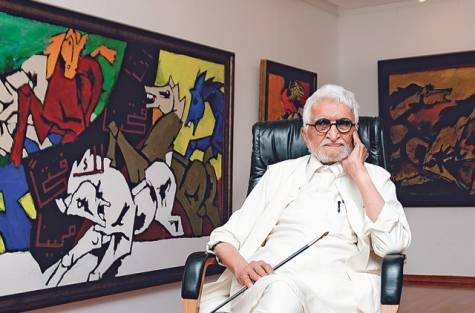
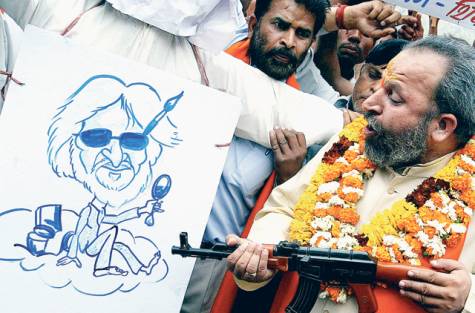
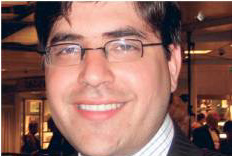 Akhil
Sibal, Husain's lawyer
Akhil
Sibal, Husain's lawyer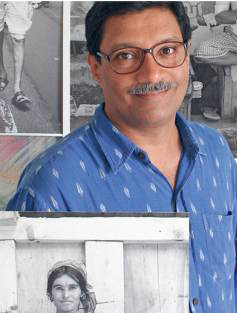 Ram
Rahman, photographer and cultural activist
Ram
Rahman, photographer and cultural activist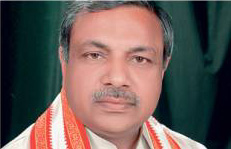 "M.F.
Husain is not absconding from India out of fear of Hindu
organisations, but because he is afraid of the results of the court
cases registered against him due to his misdeeds. For anyone trying
to evade the judicial process, the only word in legal parlance is
'absconder'. Indian citizens having faith in India and its
constitution should face the judiciary and not run away from it.
"Perhaps, Husain knows better than his blind supporters, the
consequences of insulting Mother India and Hindu gods and goddesses.
And that's the reason why he is not at all impressed by the
campaigns launched to bring him back. His followers may ignore his
double standards, but he realises his own wilfully committed sins.
If these followers want to defend him in the name of 'freedom of
expression', they should dare to paint religious leaders of other
faiths in the same manner.
"M.F.
Husain is not absconding from India out of fear of Hindu
organisations, but because he is afraid of the results of the court
cases registered against him due to his misdeeds. For anyone trying
to evade the judicial process, the only word in legal parlance is
'absconder'. Indian citizens having faith in India and its
constitution should face the judiciary and not run away from it.
"Perhaps, Husain knows better than his blind supporters, the
consequences of insulting Mother India and Hindu gods and goddesses.
And that's the reason why he is not at all impressed by the
campaigns launched to bring him back. His followers may ignore his
double standards, but he realises his own wilfully committed sins.
If these followers want to defend him in the name of 'freedom of
expression', they should dare to paint religious leaders of other
faiths in the same manner.